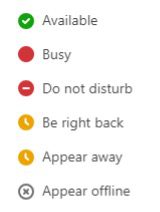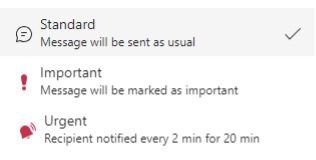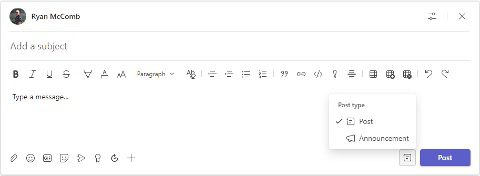We’re going to take a comprehensive look at the Chat function in Microsoft Teams to help you determine its best uses, including the powerful tools it provides for group communication.
Have you ever wondered which Chat option to use to communicate most effectively with a colleague on Microsoft Teams? Should you send your message through a Teams Channel or via Private Chat? If you choose a Channel, should you call out the entire Team or only those following that Channel? Perhaps you shouldn’t call out anyone and hope people are paying attention.
In this blog post, we’ll walk through some etiquette for the most effective ways to communicate when using Microsoft Teams’ Chat functionality.
For starters, I’ll help you determine who your audience is, identify your communication’s level of urgency, and then choose your communication option — email, a specific Team audience, a specific Channel audience within a Team, group chat, or private message to an individual.
After that, I’ll explore and help you understand additional tools – including the Chat @mention feature, announcements, and important notifications – to help you capture your intended audience’s attention without causing unneeded alarm or notifying more people than necessary.
Channels vs. Chats: What’s the Difference
First, let’s clarify how Teams Channels and Chats differ. The most obvious contrast where Microsoft Teams group Chats vs. Channels are concerned is the naming convention. Channels have a specific name that typically becomes a sub-topic apart from a Team name. While a Chat shows the names of members added to that Chat, this is the default experience when you first create a group Chat. You can, instead, give the Chat a title, which, actually, is preferable.
Although Channel messages allow Planner tabs, and group Chat doesn’t, both Chat and Channel messages essentially have the same functionality and collaborative capability. Teams stores shared files for Channel messages within a central location, while files shared within group Chats usually are stored in participants’ OneDrive accounts.
Why so much busyness within Channels? Because of what Teams Channels are: gathering places where Team members focus on a specific area within the larger Team – e.g., design, marketing or a budget – and engage in the aforementioned activities to achieve particular objectives. Channels are either standard, where all Team members can visit it, or private, where only invited people can view and access.
For people wondering about whether or not you can convert a Channel into a Chat or how to create a group Chat within the Teams Channel, there is no such feature within Teams at present.
Who is your audience, and when is it appropriate to message them?
Before we dive into the different communication options in Teams, let’s determine who your audience is and then discuss how to recognize when it’s appropriate to reach out to one person based on their status.
Here are a couple of questions to ask yourself when thinking about your audience:
- Are the people with whom you wish to communicate with all on the same Team? If the answer is ‘no,’ then a Teams group chat or an email would be a better option.
- Are the people with whom you wish to communicate internally within your company, or do you need to communicate with external folks as well? If you need to communicate externally, then knowing your company’s policy about reaching out to external users within Microsoft Teams is crucial. Some companies’ policies will not allow external guests into Teams. In that case, email is the best route.
The needs of Teams members will determine if a Channel or a Chat is the right choice. Generally speaking, though, a Channel is meant to accommodate a more expansive set of tasks, including communicating with larger Teams; collaborating on longer-form documents that require multiple replies; uploading and updating files when working together on documents or presentations; beginning projects to which specific Team members need access; and granting access to history and files, when necessary, to members outside of a group Chat.
What do the different status colors next to a person’s image or initials mean?
If you decide a private message is the right way to send your communication, please make sure you check your recipient’s status before you send it.
Chat uses status indicators to easily allow you to know whether or not a person is available merely by seeing the color that is associated with their profile. Here’s a simple breakdown of what the different Teams status indicators mean:
Email vs. Chat
Depending upon your company’s culture, if the status of your intended recipient(s) is set to red or purple, you might want to shoot them an email instead of a private Teams message or schedule a Teams message to be sent when they are not busy.
In general, avoid using email for “internal” conversations involving members of your department or Team where the Team includes everyone who needs to be in your conversation about the project or initiative you share. Making Teams the typical mode of communication in these instances can keep everybody’s email inbox from overflowing.
Chat is the way to go for one-on-one talks or discussions with a particular person or group of people, where only those people can see the messages. It’s especially good for off-the-cuff conversations in the office, where you can save the chat message in a thread that you can review if needed.
How urgent is communication, and do you need a response?
Carefully consider how fast you need to communicate information and whether you need a response quickly or not. Questions to ask yourself before continuing include:
- If I need a reply, should the entire Team, those following a specific Channel, or perhaps only a select few individuals respond
- Does the entire Team need to see my communication right away, or only those within a specific Channel?
- Could others benefit from reading the communication? Or, could others reading the conversation create a problem?
- Is my communication intended for a single person or a small group of people? And, if it’s intended for a small group of people, are they on the same Team?
- Am I sending out a question in the hope of crowdsourcing an answer quickly?
- Is my communication more of a “PSA” or “FYI” that does not require a response?
What communication options do I have?
Once you decide which members of your Team you need to notify, you can determine which communications option to use within Teams – whether your audience is internal or external and whether or not you need an immediate response.
However, the most important thing to remember is that notifications within Teams can overwhelm Team members very quickly. To be respectful of your fellow Team members’ time and attention — and to make sure they listen and respond to you when necessary — try to keep notifications to a minimum and only alert people who are actually within your intended audience whenever feasible.
Microsoft Teams offers several options for group communications and notifications, including @team, @channel, and @everyone. This functionality is great because it allows users to notify an entire Team or narrow the audience down to a specific Channel. Just type “@team” or “@channel” from the desired Team in which you are communicating, and Chat notifies the audience without having to type the specific Team or Channel’s actual name. The @everyone will alert everyone in a group Chat.
@team sends a notification to everyone who is part of your designated Team. A notification appears in the left navigation menu on the Activity icon, the name of the Team within the Teams pane becomes bold, and the channel name is bold with an icon of multiple people:
As before, the Channel bolds its name but instead of the people icon, a list icon is used.
Think of this as a small fountain firework. Only those who are close by will experience the show. The notifications are similar to @team, but with @channel, only those who are following the Channel receive notifications. The conversation also will have this Channel icon on the right border.
Each Microsoft Team can include multiple Channels for different topics. But, because not all Team members need to see all topics, members can choose to “show” or “hide” a Channel by clicking the ellipses opposite the channel name:
For when you have an urgent of Your Message
Both @team and @channel are great options for communicating urgent or important messages to a large audience easily.
But don’t forget: In some cases, it may be best to communicate by email or by sending a private message directly to a single person or small group. You don’t want to overuse group communications, both to avoid bothering people unnecessarily and to make sure when you do have something urgent to communicate, your message gets noticed.
Also remember, if the message is significant, you can mark it as important or urgent within the team or channel.
Now that you know how to determine who your audience is, how urgent your message is, and the best communication option to use, we’ll explore:
- Additional options available to you within @team and @channel.
- Helpful tips for using @team and @channel.
- Ways to call out your most urgent messages.
Using @mention to call out individuals within Teams or Channels
Within @team and @channel, you can send a message to individual Team members using @mention, where “mention” is the person’s name. Once you start a message and start typing the first name immediately after typing “@,” a drop-down will appear to help you select your intended recipient:
The notification the recipient gets once you send your message will look like the Team and Channel notifications, except only the specified user receives a notification.
Users can find these notifications by clicking the activity bell on the sidebar of Teams, which displays the name of the Team and the name of the Channel:
Clicking on a notification takes the user directly to the place in the conversation you “@mentioned” them. To continue the fireworks analogy I used earlier, this type of notification is more like a sparkler. People won’t notice it unless they are right beside you.
Please note: This is the same type of notification you receive when you use the direct Chat or a group Chat.
Whether it involves a Channel conversation or a Chat, there are different steps you can take to get the attention of an entire group.
@channel are great ways to communicate with employees who need to hear what you have to say, but keep a few additional things in mind:
- Team members who reply to a conversation will receive notifications of new responses. This feature allows the conversation to continue to flow without notifying anyone else.
- Proper etiquette for conversations within a channel is to “Reply” rather than starting a new discussion. This ensures that everyone’s comments are threaded and, kept together within the same stream, and that the flow of the conversation is easy to follow.
- If you click on the “Start a post” by mistake, please delete it and repost the comment using Reply. You will recognize this has happened right away when your comment shows up as a new conversation separate from the one to which you wanted to contribute.
- Conversations within Teams are permanent. The communication remains for the entirety of the Team’s lifecycle, so you can easily search within it if you ever need to go back and find a specific topic or comment.
- Use the search to see if others have already posted the same question or comment in a specific Team or Channel. That way, you aren’t clogging up the feed with redundancy.
Taking it to the next level: announcements and “Mark as important”
Finally, sometimes your message may be so urgent you need to get people’s attention quickly. Creating an announcement or using the “Mark as important” feature are great ways to do this — but only when it’s essential.
Creating an Announcement
To create an Announcement, click on the “Start a post” icon, then click on the icon beside Post:
Now you can choose Announcement. This will change the post by adding a headline section at the top. Use this to grab your audience’s attention. You can even change the background color if you desire.
Using “Mark as important”
To use “Mark as important,” click on the exclamation mark icon in the toolbar.
To be clear, this option is available within any form of chat communication inside Teams. You can also use it inside of a Private Chat.
(You can also employ a keyboard shortcut, if you like, in lieu of selecting “Mark as important.”)
Creating an announcement or using “Mark as important” is like using a huge firework, which may startle people as well as get their attention. Sometimes that’s appropriate, but often it’s not. Use these features sparingly and only for communications that are truly important, urgent, or beneficial to a large portion of your audience. That way, you will avoid unduly alarming people, and make sure they do pay attention when you use these tools.
If your peers tend to respond quicker to email, and the urgency of the communication is high, send an email rather than using Chat within Teams. If the opposite is true, and your peers respond to Teams Chat faster than email, then use the built-in features of Microsoft Teams to your advantage.
Better Etiquette Makes for More Effective Communications
Only you can determine your audience and how best to communicate with them. When sending your communication, try not to set off a large firework when a sparkler will do.
Hopefully, this post provides you with a better understanding of notifications and Chat etiquette to help your Microsoft Teams communications become more effective. Remember, the more respectful you are with other people’s time and attention on Teams, the louder your voice will be whenever you communicate.












